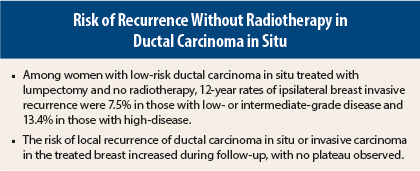Lawrence J. Solin, MD, of Albert Einstein Healthcare Network, Philadelphia, and colleagues reported the 12-year results from the ECOG-ACRIN E5194 trial in the Journal of Clinical Oncology. Among women with ductal carcinoma in situ with low-risk clinical and pathologic characteristics, they found that surgical excision without radiation therapy was associated with ipsilateral breast invasive recurrence in 7.5% of those with low- or intermediate-grade disease and 13.4% of those with high-grade disease at 12 years. The risk increased over time, with no plateau observed.1 The clinical trial was conducted by the Eastern Cooperative Oncology Group and the American College of Radiology Imaging Network (ECOG-ACRIN).
Study Details
In the nonrandomized ECOG-ACRIN E5194 study, women with ductal carcinoma in situ with low-risk clinical and pathologic characteristics were assigned to two cohorts between April 1997 and October 2002: Cohort 1 (n = 561) had low- (50%) or intermediate-grade (50%) ductal carcinoma in situ and a tumor size ≤ 2.5 cm; cohort 2 (n = 104) had high-grade ductal carcinoma in situ and a tumor size ≤ 1 cm. Enrollment and cohort assignment were based on clinical and pathology assessment at treating institutions.
All patients underwent surgical excision (lumpectomy) of the primary ductal carcinoma in situ tumor and received no radiation therapy. Excision was to have a minimum negative margin width of ≥ 3 mm or no tumor on re-excision. The primary endpoint of the study was an ipsilateral breast event, defined as the first local recurrence of ductal carcinoma in situ or invasive carcinoma in the treated breast.
For cohorts 1 and 2, patient ages were ≤ 39 years in 2% and 4%, 40–49 in 17% and 20%, 50–59 in 30% and 29%, 60–69 in 26% and 27%, and ≥ 70 years in 25% and 20%. Most of the patients in both cohorts were white, and approximately three-quarters were postmenopausal. The tumor size was ≤ 5 mm in 40% and 27%, 6–10 mm in 41% and 59%, and > 10 mm in 19% and 14%; the minimum negative margin width was 3 to 4.9 mm in 33% and 27%, 5–9.9 mm in 43% and 45%, and ≥ 10 mm in 21% and 24%.
In patients in cohorts 1 and 2, 31%, and 24% had received tamoxifen, and approximately 45% had received hormone replacement therapy prior to study entry. The College of American Pathologists (CAP) grade was low, intermediate, and high in 15%, 59%, and 26% and in 2%, 24%, and 74%, respectively.
Ipsilateral Breast Events
Median follow-up was 12.3 years. A total of 99 ipsilateral breast events were observed (74 in cohort 1 and 25 in cohort 2), including 51 invasive ipsilateral breast events (52%; 39 in cohort 1 and 12 in cohort 2). The 12-year rates of an ipsilateral breast event were 14.4% for cohort 1 and 24.6% for cohort 2 (P = .003), and the 12-year rates of an invasive ipsilateral breast event were 7.5% and 13.4% (P = .08). The risks of developing an ipsilateral breast event and an invasive ipsilateral breast event increased over time through 12 years, with no plateau observed. In cohort 1, the rates of developing an ipsilateral breast event and an invasive ipsilateral breast event were approximately 1.2% and 0.6% per year through year 12. At 12 years, overall survival was 84.0% and 82.8% (P = .96), and the incidence of contralateral breast cancer events was 6.7% and 12.0% (P = .16).
On multivariate analysis, the study cohort (hazard ratio [HR] = 1.84, P = .009, for cohort 2 vs 1) and tumor size (HR = 2.11, P = .03, for > 10 mm vs ≤ 5 mm) were significantly associated with the occurrence of ipsilateral breast event. Factors that were not significantly associated included age, menopausal status, minimum negative margin width, method of detection, bloody nipple discharge, tamoxifen use, and prior hormone therapy. On multivariate analysis for an invasive ipsilateral breast event, the study cohort was of borderline significance (P = .08), with no other factor being significant.
Findings With CAP Grading
In a subset of 500 patients with central pathology review using current CAP guidelines for ductal carcinoma in situ, 12-year rates of an ipsilateral breast event were 12.5% for low-grade disease, 15.1% for intermediate-grade disease, and 20.6% for high-grade disease (P = .16). The 12-year rates for an invasive ipsilateral breast event were 5.5%, 6.7%, and 11.7% (P = .19), respectively.
The investigators concluded: “[T]his study has demonstrated that the risks of developing an ipsilateral breast event and an invasive ipsilateral breast event increased over time through 12 years of follow-up, without plateau, for patients with ductal carcinoma in situ of the breast who were selected for favorable clinical and pathologic characteristics and treated with surgical excision without radiation. Individual patients and their physicians will need to decide if these 12-year risks are acceptable and to judge whether or not to add adjuvant treatment after surgical excision. Not all patients and their physicians will agree on what is considered too high a risk of developing an ipsilateral breast event or an invasive ipsilateral breast event to recommend observation after surgical excision or what risk is considered too low to justify adding radiation treatment. However, this study provides 12-year data to begin those discussions and to help inform the treatment decision-making process.” ■
Disclosure: The study was supported in part by the National Cancer Institute and Breast Cancer Research Foundation. For full disclosures of the study authors, visit jco.ascopubs.org.
Reference
1. Solin LJ, Gray R, Hughes LL, et al: Surgical excision without radiation for ductal carcinoma in situ of the breast: 12-year results from the ECOG-ACRIN E5194 study. J Clin Oncol 33:3938-3944, 2015.



